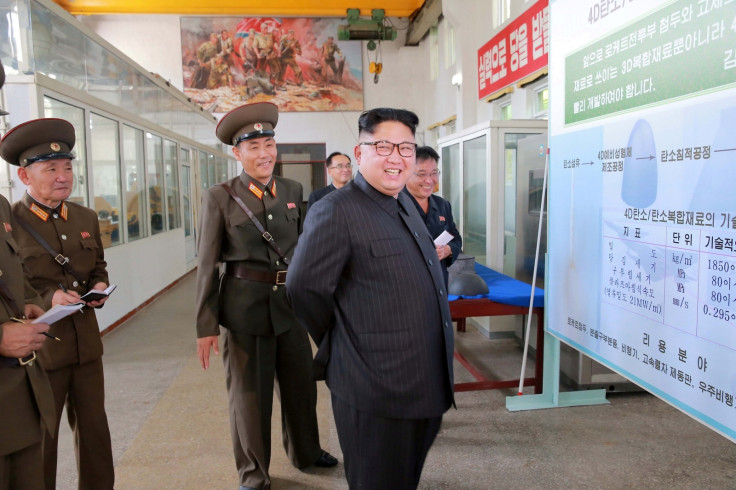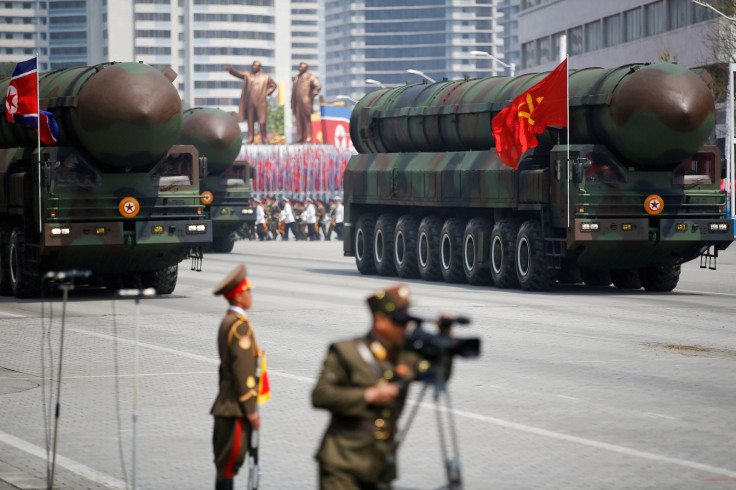Kim Jong-un orders production of more ICBM warhead tips and rocket engines after weeks of tensions
The latest move by Pyongyang comes as the US sees signs of restraint from the Kim regime in recent days.
North Korean dictator Kim Jong-un has ordered Pyongyang's key science institute to produce more solid-fuel rocket engines and warheads, just as the US said the reclusive country has shown some restraint with its nuclear and missiles programmes.
Kim gave the instructions to increase the production of the equipment during his tour of the Chemical Material Institute of the Academy of Defence Science, the North's official KCNA news agency said on Wednesday (23 August).
However, the report does not mention when Kim visited the institute where he was briefed about the process of manufacturing of intercontinental ballistic missile (ICBM) warhead tips and rocket engines.
The production will be increased by "further expanding engine production process and the production capacity of rocket warhead tips and engine jets by carbon and carbon compound material", at the institute, KCNA reported.
The latest move by Kim is likely to be seen as the isolated country's resolve to develop ICBMs capable of reaching the US mainland.
Meanwhile, KCNA has also unveiled a photo – believed to be taken inside the institute – which according to Yonhap indicates that the North is developing a new ballistic missile, called the Pukguksong-3, to be launched with a solid-fuel engine.
The photograph shows Kim in a grey pinstriped suit, smiling before a large flow chart, which apparently reads what the regime calls the underwater strategic Pukguksong-3 ballistic missile.
South Korean analysts believe the North could test-fire a new type of submarine-launched ballistic missile (SLBM) with a solid-fuel engine.
Kim's visit to the institute comes after weeks of heightened tensions between North Korea and the US following Pyongyang's two successful ICBM tests in July. It prompted a bitter war of words, raising fears of a new conflict in the Korean peninsula.

The second ICBM, called the Hwasong-14 was fired on 28 July, which some analysts fear might put much of the US territories, including Chicago and Los Angeles, within Pyongyang's striking range.
However, an analysis by the New York Times said North Korea still has a long way to go before it can successfully develop an ICBM.
The report says while it is relatively easy to send an ICBM into the void of outer space, it is very difficult to bring it down in order to attack the US.
This is because the missile has to travel to the outer space and make an atmospheric re-entry to earth. And due to the waves of blistering heat, a warhead, if badly engineered, will burn up much before it comes closer to hitting its target.
"If the North keeps up its rate of missile tests, it will likely have perfected a crude re-entry vehicle by next year, if it doesn't possess one already, private analysts say," the NYT report said.
The temperature in the Korean peninsula seems to have reduced a bit recently after fresh UN sanctions were imposed against Kim's regime earlier this month.

US Secretary of State Rex Tillerson noted what he called restraint Pyongyang has shown in recent days. He said it could mean a path is opening to a possible dialogue between the two sides.
"We have had no missile launches or provocative acts on the part of North Korea since the unanimous adoption of the UN Security Council resolution," Tillerson told reporters on Tuesday (22 August).
"We hope that this is the beginning of this signal that we've been looking for - that they are ready to restrain their level of tensions, they're ready to restrain their provocative acts, and that perhaps we are seeing our pathway to sometime in the near future having some dialogue," he added.
© Copyright IBTimes 2025. All rights reserved.





















